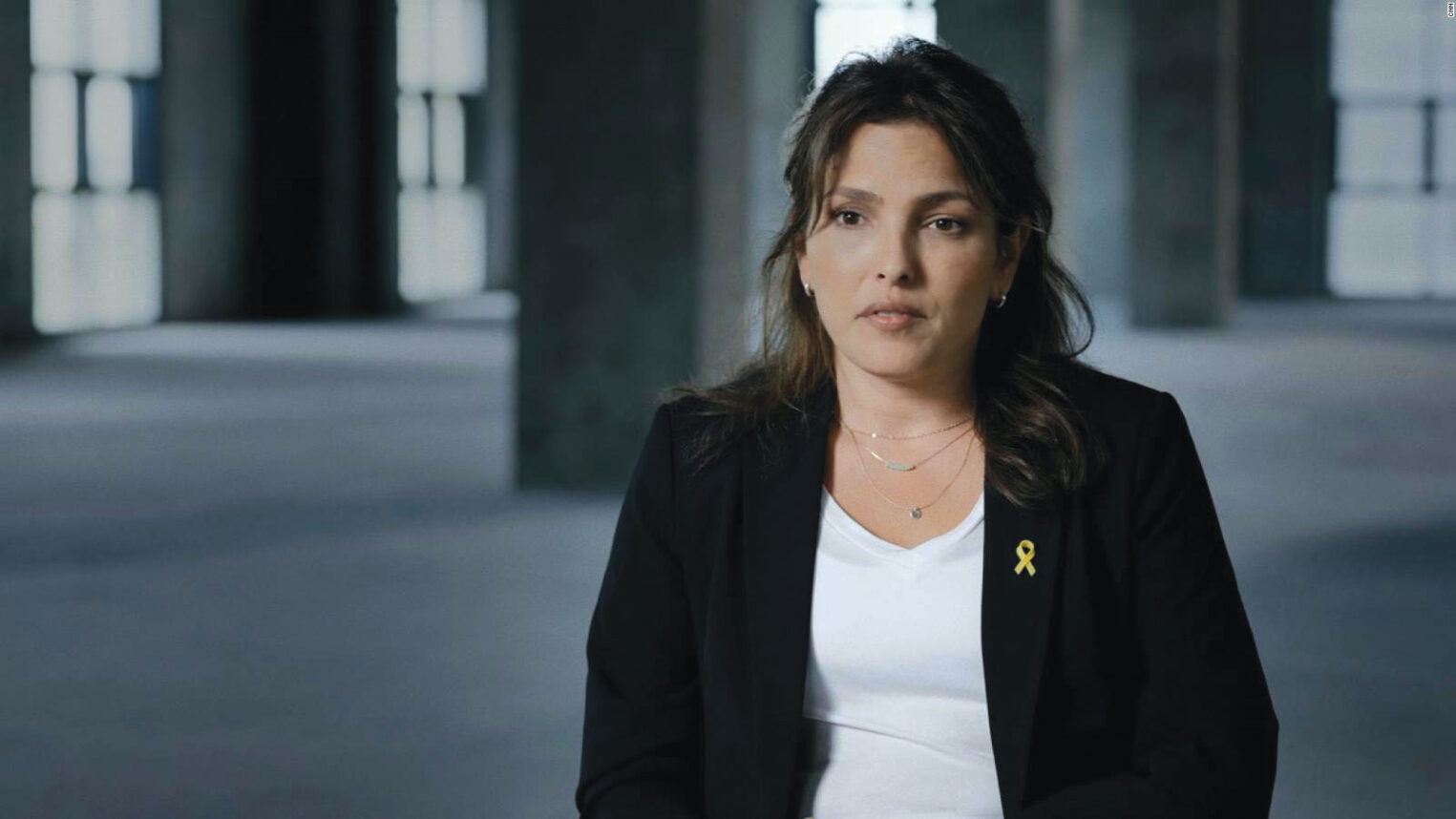Dame Helen Mirren may be best known for her portrayal of Elizabeth II in Stephen Frears’ 2006 film, “The Queen,” for which she received an Academy Award, and her public persona, as well, appears always to exude a measure of both elegance and hauteur — so much so that Frears reportedly once said he hired her, in part, because it was crucial to cast an actress who made one feel a bit nervous.
But during a recent telephone interview from New York, the 69-year-old actress, while formidable, also evinced a keen vulnerability, and at one point seemed close to tears. She was describing her new film, Simon Curtis’ “Woman in Gold,” based on the true story of Maria Altmann (played by Mirren), a Viennese Holocaust survivor who, late in her life and as a Los Angeles resident, successfully sued the Austrian government for the return of five Gustav Klimt paintings that had been stolen from her family by the Nazis — including the famous gold-flecked portrait of her aunt, Adele Bloch-Bauer, that had hung for decades in Vienna’s Belvedere Museum and had been dubbed “The Austrian Mona Lisa.”
During a break from the film’s production, Mirren said, she visited the Belvedere and stood before another Klimt portrait, this one of Amalie Zuckerkandl, who later perished in the concentration camp Belzec. “On the set we had a beautiful reproduction of the Klimt of Adele Bloch-Bauer, and when I turned the corner and first saw it, it took my breath away,” Mirren recalled. “But it was the painting of Amalie that made me cry, and made me just speechless,” she added with a heavy sigh.
“It’s a rather beautiful portrait, unfinished, of this young woman looking out at you. And that woman died in a death camp, but there she is hanging on the wall. Now Adele died before the war, of meningitis, in her 40s, but had she lived, she, too, would likely have died in a camp. And if she had, do you think the Austrians would have so proudly displayed her portrait as the Mona Lisa of Austria?” Mirren asked, her hushed voice turning incredulous and sardonic. “Would they have said, ‘There she is, we love her — and she died in [a] death camp by the way?’ So it was that portrait of Amalie that helped bring Maria’s story together for me in one image.”
Before Mirren read the script for “Woman in Gold,” she had not previously known the story of Altmann, who fled the Nazis with her husband in 1938, endured the death of much of her family, immigrated to L.A. and, in the late 1990s, hired L.A. attorney E. Randol Schoenberg (played in the film by Ryan Reynolds — see sidebar) to battle the Austrians for the return of her family’s Klimts. “I don’t know how the story escaped me, because it’s just incredible, and I do read the newspaper every day,” said Mirren, whose character is played as a younger woman by actress Tatiana Maslany. “But it was a wonderful story to discover.”
What intrigued Mirren about Altmann, who died in 2011 at 94? “My God, it’s hard to know where to start,” the actress said. Along with the survivor’s fortitude throughout her seven-year legal battle, Mirren was riveted by a video of a lengthy legal deposition Altmann gave during her case. “She interjected occasionally, very cleverly, very wittily and astutely,” the actress recalled. “And just watching her watch her [opponents] was so wonderful. She had this amazing look of this sort of wonderful bird of prey, without the aggression — just this elegant, intellectually refined, restrained look. And I thought, ‘If I can just get that look down, I’ll be so happy.’
“To try to portray her, of course I looked at the superficial things — her gestures, the way she sat, the way she held her back, the way she patted her hair,” Mirren added. “But my primary job and my effort in the movie was to try to engage with her memory and find a way to transport that to the screen. And that meant therefore to look at documentary footage and to read books on Vienna and the Holocaust — to remind myself of what her memories might have been and to have that very forward and present in my mind.”
Mirren drew, as well, on her experience playing a very different kind of Holocaust survivor in John Madden’s 2010 thriller “The Debt,” based on the Israeli film “Ha-Hov.” In that drama, she portrayed a tormented ex-Mossad agent, Rachel Singer, who is called upon to assassinate a sadistic Nazi physician who had eluded her on a secret mission decades earlier.
As research for the role, Mirren immersed herself in reading about Israeli and Mossad history, the Nazi hunter Simon Wiesenthal, and the murder of European Jewry; she even took a crash course in Hebrew. The characters of Singer and Altmann share a kind of repressed rage about the Holocaust, “But with Rachel the anger is more at the forefront, because it’s become her job to remember and make remembrance drive her forward into seeking retribution,” Mirren said.
Altmann, too, was consumed by the desire for justice, “But as I saw in her deposition, her anger was utterly restrained, utterly dignified,” the actress said. “I strove to depict that and also her sense of being haunted by the past — but not dwelling on it, not using it cheaply, not miserably regurgitating it in a self-pitying way. There was no self-pity in Maria whatsoever.”
Mirren’s reputation for playing royalty is well-known — not only for her performance in “The Queen,” but also for her turn as Cleopatra in stage versions of Shakespeare’s “Antony and Cleopatra,” Queen Charlotte in the 1994 film “The Madness of King George,” for which she received an Oscar nomination, and as Elizabeth Windsor, yet again, in the current production of “The Audience” on Broadway. She once joked that she didn’t care if she spoke any lines in a particular project, so long as she got to wear a crown.
Her performance as Maria Altmann is also majestic — no matter that the Holocaust survivor was, in fact, a low-key woman who continued to live in her tidy home in Cheviot Hills and to drive a beloved Chevy jalopy, even after she sold her aunt’s portrait to art collector and philanthropist Ronald S. Lauder in 2006 for a staggering $135 million. (The picture now hangs in New York’s Neue Galerie, a museum of Austrian art founded by Lauder.) While Mirren is petite and glamorous — she was known for being something of a sex symbol early in her career — Altmann was tall and unassuming.
But Mirren insisted that her portrayal of the survivor wasn’t unnecessarily regal. “I have to say that Maria had that quality,” the actress said. “In a way, I would have preferred her not to, because this ‘queen’ thing is beginning to follow me around. But Maria did have a regality about her. If you look at pictures and, especially, film of her, you can see that she could have played the queen beautifully. She would have been a spectacular queen.”
Just as Altmann grew up in an upper-crust household but lost everything during World War II, Mirren was raised with stories of her family’s vanished aristocratic world. Her great-grandmother had been a Russian countess, and her grandfather, Pyotr Mironov, regaled the young Helen (born Helen Mironoff and called Ilyena throughout her childhood) with tales of his family’s vast estate, Kuryanov, near the town of what is now Gagarin.
“My grandfather was in the czarist army, and was probably responsible for some anti-Semitic acts — I wouldn’t be surprised,” Mirren said.
Mironov arrived in Britain as an emissary of the czar during World War I and was trapped there upon the eve of the Soviet revolution in 1917. “Within 10 or 15 years, he had become a cab driver because that was the only way to survive,” Mirren said. But her grandfather revered the images of the former czar and czarina he had hung on the wall of his room in Mirren’s childhood home in a working-class neighborhood of Leigh-on-Sea in Essex.
Mirren’s father, Vasily Mironoff, worked for a time for a Jewish tailor in the Jewish neighborhood of London’s East End and also drove a taxi; he was a socialist who participated in demonstrations against the British fascists who marched through the East End before World War II and was caught up in the ensuing Battle of Cable Street riot of 1936. Mironoff, who very much wanted to assimilate into British society, changed the family’s surname to the Anglicized Mirren after his father died decades ago.
But, Mirren said, she would never compare her family’s experience to Altmann’s. “It was a much slower downward trajectory,” she said. “It wasn’t as immediate and quick as what happened to European Jewry — the terrifying speed with which that occurred was so brutal and incomprehensible.”
As a young actress, Mirren sought to overcome her humble roots, in part, by becoming “the Sarah Bernhardt of my generation,” she told The New Yorker in 2006; she has gone on to become one of the most esteemed actresses of her generation, appearing in dozens of stage, film and TV productions, including her acclaimed portrayal of chief inspector Jane Tennison in the well-received British television series “Prime Suspect.”
The reviews for “Woman in Gold” thus far have not been so favorable, with some critics remarking of an earlier version of the film that it was heavy handed, or allegedly exploited the Holocaust for dramatic purposes, with one critic going so far as to call it a “treacly, sentimental treatment drowned in kitsch.” [Author's note: Since those early reviews at the Berlin International Film Festival, the filmmaker has made changes to “Woman in Gold”; the audience cheered after a recent L.A. screening sponsored by groups such as the Anti-Defamation League and the Los Angeles Museum of the Holocaust, an ADL spokesperson said.] Mirren’s response to the early negative reviews is fierce: “It’s disgusting to look at the film in that way,” she said. “It’s an attempt that is super-cynical, super ‘above it all,’ perhaps because it’s very hard to confront the reality of something like Maria’s story. And I find that appalling.”
Mirren, however, would have welcomed Altmann’s opinion of her performance. “My only sadness is that I didn’t get to meet her and receive her critique,” the actress said. “Of course, I’m trying to channel Maria, but it’s only my portrait of Maria. I’m sure she would have said, ‘I’m not like that at all.’ ”
“Woman in Gold” opens in theaters April 1






















 More news and opinions than at a Shabbat dinner, right in your inbox.
More news and opinions than at a Shabbat dinner, right in your inbox.